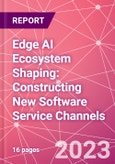This paradigm is known as Edge Artificial Intelligence (Edge AI). In recent years, many international brands have actively entered the Edge AI space, highlighting its significance in the market. Moreover, Edge AI differs slightly from the traditional information software industry in terms of sales channels and development models. Therefore, existing software companies and information service providers need to make adjustments to seize the growth opportunities in this evolving landscape.
This product will be delivered within 3-5 business days.
Table of Contents
1. The Drive for Timeliness: Shaping Edge AI1.1 Natural Technological Evolution and Practical Demands in Edge AI
1.2 Edge AI's Resemblance to Edge Computing and Its Advantages
1.3 Edge AI Weaknesses Compared to Cloud AI
2. Global Hardware and Software brands' Aggressive Expansion into Edge AI
2.1 Chipmakers' Strategies in Edge AI
2.2 Startups in the Edge AI Space
2.3 Major Cloud Providers' Involvement in Edge AI
3. Edge AI Development Adapting to Multiple New Software Models
3.1 Cloud-Based Edge AI Development Tools
3.2 Diverse Approaches to Edge AI Inference Software: Embedded and Marketplace Routes
3.3 Diverse Approaches and Billing Methods in Edge AI Deployment
4. Publisher Perspective
Appendix
List of Companies
List of Tables
Table 1: A Comparison of Characteristics between Cloud AI and Edge AI
List of Figures
Figure 1: Evolutionary Timeline of Edge Artificial Intelligence Technologies
Figure 2: Architecture and Principles of Horizontal Federated Learning Systems
Figure 3: Intel's Integration of OpenVINO Software to Support AI Acceleration Chips
Figure 4: Illustration of AWS IoT Greengrass ML Inference Service
Figure 5: SensiML SaaS Billing Model
Figure 6: Edge AI Utilizing Cloud Application Marketplace Delivery and Update Mechanisms
Companies Mentioned (Partial List)
A selection of companies mentioned in this report includes, but is not limited to:
- Anagog
- AWS
- DeepSig
- FogHorn Systems
- GoEdge.ai
- Gorilla Technology
- Hacarus
- Imagimob
- Intel
- Kneron
- Mavenir
- Micro.ai
- Microsoft
- Nvidia
- QuickLogic
- SensiML
Methodology
Primary research with a holistic, cross-domain approach
The exhaustive primary research methods are central to the value that the analyst delivers. A combination of questionnaires and on-site visits to the major manufacturers provides a first view of the latest data and trends. Information is subsequently validated by interviews with the manufacturers' suppliers and customers, covering a holistic industry value chain. This process is backed up by a cross-domain team-based approach, creating an interlaced network across numerous interrelated components and system-level devices to ensure statistical integrity and provide in-depth insight.
Complementing primary research is a running database and secondary research of industry and market information. Dedicated research into the macro-environmental trends shaping the ICT industry also allows the analyst to forecast future development trends and generate foresight perspectives. With more than 20 years of experience and endeavors in research, the methods and methodologies include:
Method
- Component supplier interviews
- System supplier interviews
- User interviews
- Channel interviews
- IPO interviews
- Focus groups
- Consumer surveys
- Production databases
- Financial data
- Custom databases
Methodology
- Technology forecasting and assessment
- Product assessment and selection
- Product life cycles
- Added value analysis
- Market trends
- Scenario analysis
- Competitor analysis

LOADING...








